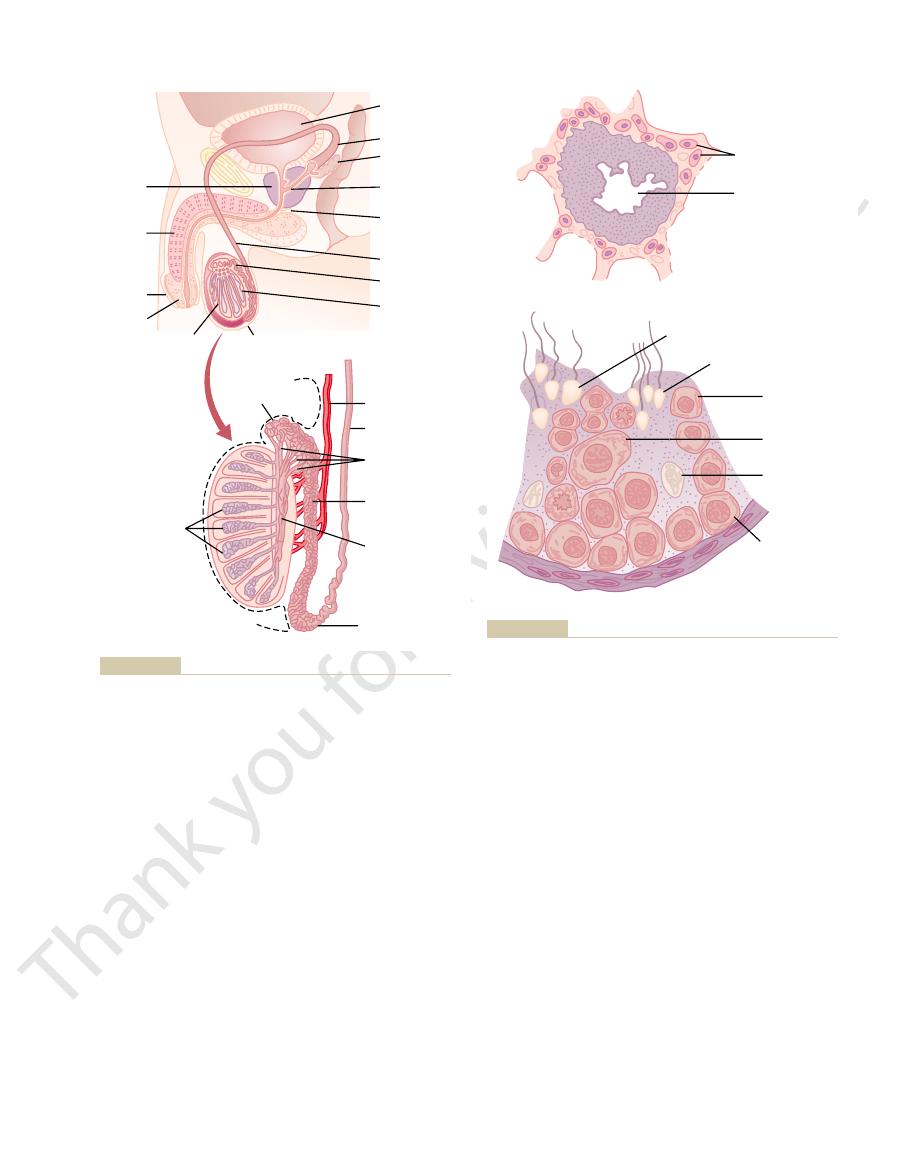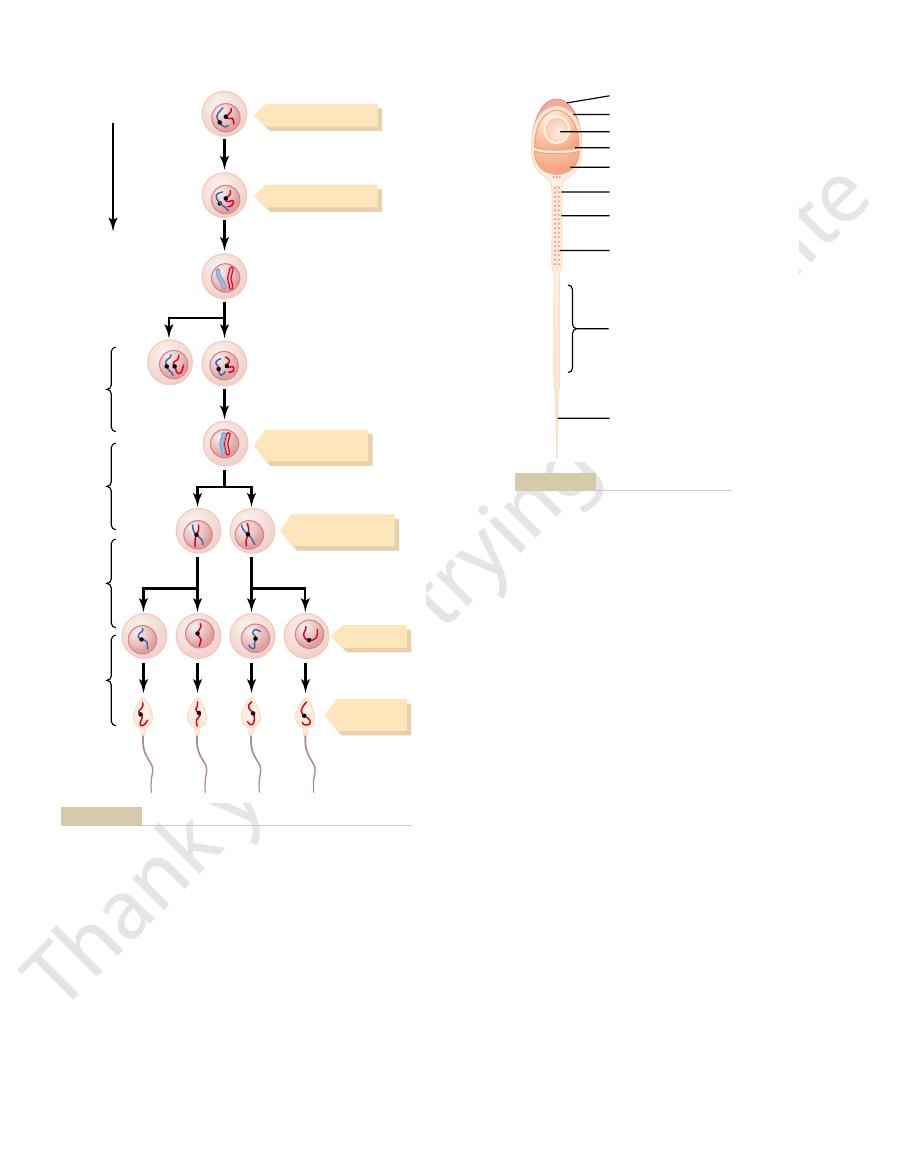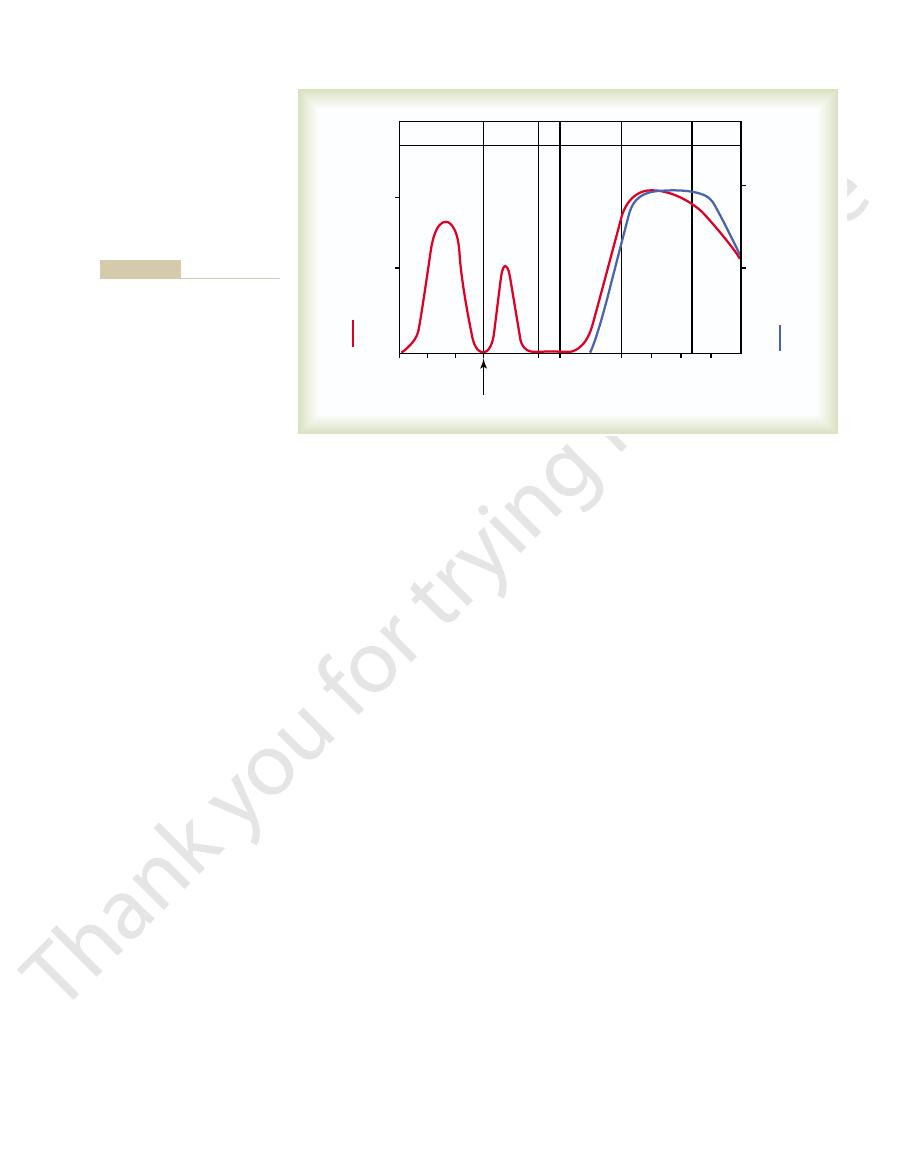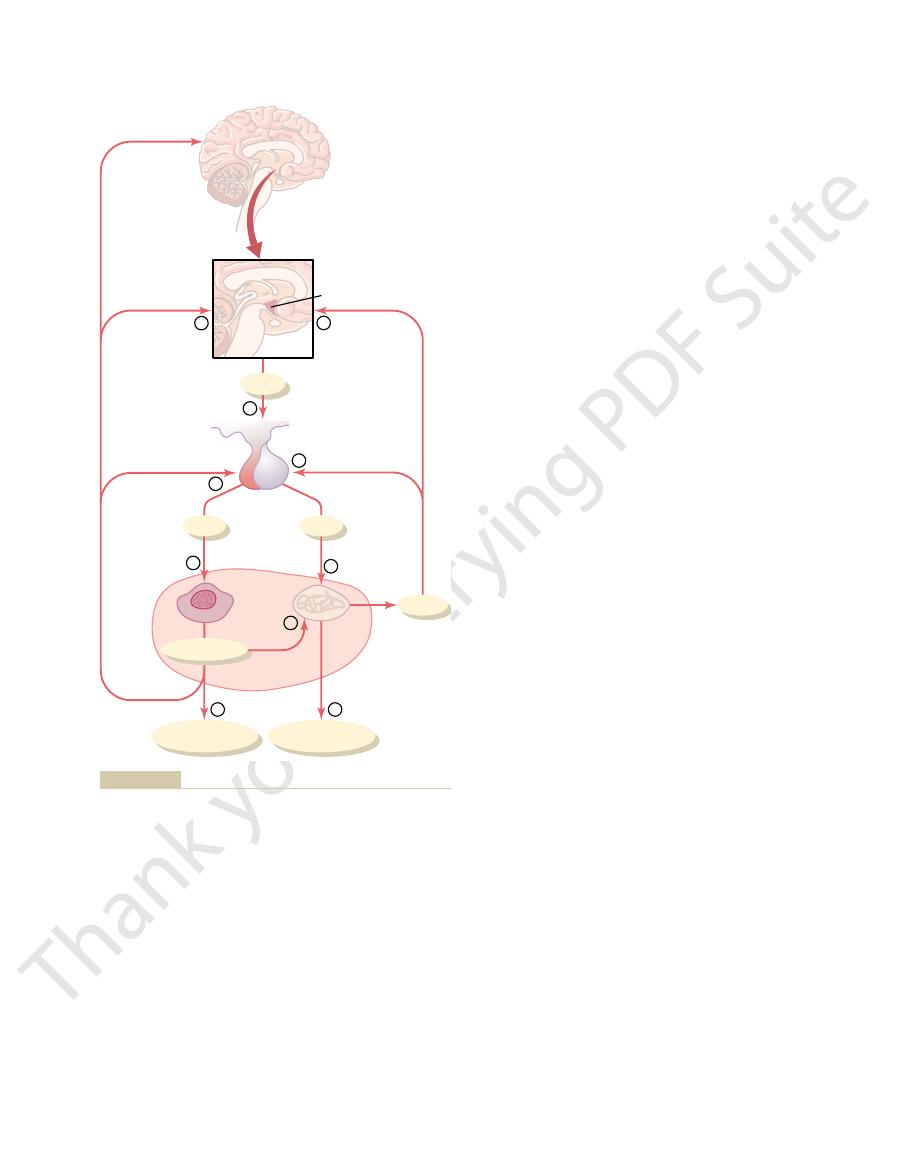
toward the central lumen of the seminiferous tubule. The Sertoli
In the first stage of spermatogenesis, the spermatogonia migrate among
remainder of life but decreasing markedly in old age.
the result of stimulation by anterior pituitary gonadotropic hormones, begin-
through definite stages of development to form sperm, as shown in Figure
division, beginning at puberty, and continually proliferate and differentiate
). The spermatogonia begin to undergo mitotic
of one is shown in Figure 80–2
primordial germ cells
During formation of the embryo, the
Spermatogenesis
(Cowper’s glands) located near the origin of the urethra.
is the last connecting link from the testis to the exterior. The
Finally, the
, too, empty from the
internal urethra. Prostatic ducts
static end of the ampulla, and the contents from both the ampulla and the seminal
, one located on each side of the prostate, empty into the pro-
Two
, which enlarges into the
, another coiled tube about 6 meters long. The epididymis leads into the
half meter long, in which the sperm are formed. The sperm then empty into the
seminiferous tubules,
gives a more detailed structure of the testis and epididymis. The testis
Figure 80–1
shows the various portions of the male reproductive system, and
Figure 80–1
Male Sexual Organs
lar metabolism, growth, and other functions of the body.
sex hormones on the accessory sexual organs, cellu-
by the various hormones. Associated with these
sperm; (2) performance of the male sexual act; and
matogenesis, which means simply the formation of
divided into three major subdivisions: (1) sper-
The reproductive functions of the male can be
C
H
A
P
T
E
R
8
0
996
Reproductive and Hormonal
Functions of the Male (and
Function of the Pineal Gland)
(3) regulation of male reproductive functions
reproductive functions are the effects of the male
Physiologic Anatomy of the
A
B
is composed of up to 900 coiled
each averaging more than one
epididymis
vas deferens
ampulla of the vas deferens immediately before
the vas enters the body of the prostate gland.
seminal vesicles
vesicles pass into an ejaculatory duct leading through the body of the prostate gland
and then emptying into the
prostate gland into the ejaculatory duct and from there into the prostatic urethra.
urethra
urethra is supplied with mucus derived from a large number of minute urethral
glands located along its entire extent and even more so from bilateral bulbourethral
glands
migrate into the
testes and become immature germ cells called spermatogonia which lie in two
or three layers of the inner surfaces of the seminiferous tubules (a cross section
A
80–2B.
Steps of Spermatogenesis
Spermatogenesis occurs in the seminiferous tubules during active sexual life as
ning at an average age of 13 years and continuing throughout most of the
Sertoli cells

80–4, each spermatozoon is composed of a
and elongate into spermatozoa. As shown in Figure
epithelioid cells, but soon they begin to differentiate
formed, they still have the usual characteristics of
When the spermatids are first
Chapter 82.
fertilizes the ovum. This is discussed further in
. The sex of the eventual offspring is
, and the female X chro-
the male Y chromosome goes to one spermatid that
. During meiotic division,
male chromosome
some, the
, and one Y chromo-
female chromosome
This pair is composed of one X chromosome, which is
tion that determines the sex of each eventual offspring.
In each spermatogonium, one of the
matogonia to spermatozoa, takes about 74 days.
The entire period of spermatogenesis, from sper-
oocyte provided by the mother.
the father, while the other half are derived from the
to the second spermatid. This also divides the chro-
chromosomes) of the spermatocyte are divided, so that
the spermatid stage, the 46 chromosomes (23 pairs of
During the change from the spermatocyte stage to
spermatozoa
another few days, these too divide to form
. After
Each of these, in turn, undergoes meiotic
(Figure
nia all the way to the central lumen of the tubule.
cells are very large, with overflowing cytoplasmic
Chapter 80
Reproductive and Hormonal Functions of the Male (and Function of the Pineal Gland)
997
envelopes that surround the developing spermatogo-
Meiosis.
Spermatogonia that cross the barrier into the
Sertoli cell layer become progressively modified and
enlarged to form large primary spermatocytes
80–3).
division to form two secondary spermatocytes
spermatids
that are eventually modified to become
(sperm).
23 chromosomes go to one spermatid and the other 23
mosomal genes so that only one half of the genetic
characteristics of the eventual fetus are provided by
Sex Chromosomes.
23 pairs of chromosomes carries the genetic informa-
called the
then becomes a male sperm
mosome goes to another spermatid that becomes a
female sperm
determined by which of these two types of sperm
Formation of Sperm.
head and a
Prepuce
Glans
penis
Seminiferous
tubules
Testis
A
B
Scrotum
Head of
epididymis
Erectile
tissue
Prostate
gland
Urinary
bladder
Ampulla
Seminal
vesicle
Ejaculatory
duct
Bulbourethral
gland
Vas deferens
Vas deferens
Efferent
ductules
Body of
epididymis
Rete testis
Tail of epididymis
Epididymis
Seminiferous
tubules
Testicular artery
Physiology. Philadelphia: Saunders College Publishing, 1985.)
testis to the epididymis. (Redrawn from Guyton AC: Anatomy and
Internal structure of the testis and relation of the
DW: Textbook of Histology, 10th ed. Philadelphia: WB Saunders
Male reproduction system. (Modified from Bloom V, Fawcett
Figure 80–1
A,
Co, 1975.) B,
Seminiferous
tubules
B
A
Interstitial cells
Secondary
spermatocyte
Spermatozoa
Primary
spermatocyte
Spermatogonium
Sertoli cell
Spermatids
opment of sperm from spermatogonia.
Cross section of a seminiferous tubule.
Figure 80–2
A,
B, Stages in the devel-

in the interstitium of the testis, is essential for
, secreted by the
Testosterone
mones play essential roles in spermatogenesis. Some
later, but at this point, let us note that several hor-
We shall discuss the role of hormones in reproduction
Spermatogenesis
Hormonal Factors That Stimulate
of 1 to 4 mm/min. This allows them to move through
tubules that make up the axoneme. The energy for this
movement) provides motility for the sperm. This
axoneme; and (3) a collection of mitochondria sur-
Chapter 2; (2) a thin cell membrane covering the
of 11 microtubules, collectively called the
major components: (1) a central skeleton constructed
, has three
The tail of the sperm, called the
(which can digest proteins). These enzymes play
found in lysosomes of the typical cell, including
This contains a number of enzymes similar to those
that is formed mainly from the Golgi apparatus.
layer around its surface. On the outside of the anterior
cell with only a thin cytoplasmic and cell membrane
. The head comprises the condensed nucleus of the
998
Unit XIV
Endocrinology and Reproduction
tail
two thirds of the head is a thick cap called the acro-
some
hyaluronidase (which can digest proteoglycan fila-
ments of tissues) and powerful proteolytic enzymes
important roles in allowing the sperm to enter the
ovum and fertilize it.
flagellum
axoneme—
the structure of this is similar to that of cilia found
on the surfaces of other types of cells described in
rounding the axoneme in the proximal portion of the
tail (called the body of the tail).
Back-and-forth movement of the tail (flagellar
movement results from a rhythmical longitudinal
sliding motion between the anterior and posterior
process is supplied in the form of adenosine triphos-
phate that is synthesized by the mitochondria in the
body of the tail.
Normal sperm move in a fluid medium at a velocity
the female genital tract in quest of the ovum.
of these are as follows:
1.
Leydig cells located
Primordial germ cell
Enters
testis
Spermatogonia
Primary
spermatocyte
Secondary
spermatocytes
Meiotic division II
Differentiation
Meiotic division I
Spermatids
Mature
sperm
Spermatogonia
proliferate by mitotic
cell division inside
testis
Birth
Puberty
25 days
12-14
years
9 days
19 days
21 days
spermatozoa.
spermatocytes produce spermatids, which differentiate to form
cytes. After completion of meiotic division II, the secondary
through meiotic division I to become secondary spermato-
begin meiosis to become primary spermatocytes and continue
after birth), the spermatogonia proliferate rapidly by mitosis. Some
they become spermatogonia. At puberty (usually 12 to14 years
development the primordial germ cells migrate to the testis where
Cell divisions during spermatogenesis. During embryonic
Figure 80–3
Acrosome
Surface membrane
Vacuole
Anterior head cap
Posterior head cap
Neck
Body
Mitochondria
Chief piece of tail
End piece of tail
Structure of the human spermatozoon.
Figure 80–4

act, is composed of the fluid and sperm from the vas
Semen, which is ejaculated during the male sexual
ejaculation, and thus enhances the motility and fertil-
rises to about 6.0 to 6.5. Consequently, it is probable
acidic (pH of 3.5 to 4.0). Sperm do not become opti-
fertility. Also, the vaginal secretions of the female are
the sperm and, consequently, helps to inhibit sperm
successful fertilization of the ovum, because the fluid
the bulk of the semen. A slightly alkaline characteris-
thin, milky fluid of the prostate gland adds further to
enzyme, and a profibrinolysin. During emission, the
tains calcium, citrate ion, phosphate ion, a clotting
The prostate gland secretes a thin, milky fluid that con-
Function of the Prostate Gland
and (2) by possibly causing backward, reverse peri-
two ways: (1) by reacting with the female cervical
semen, and the fructose and other substances in the
sperm. This adds greatly to the bulk of the ejaculated
During the process of emission and ejaculation, each
, and other nutrient substances, as well
Each seminal vesicle is a tortuous, loculated tube lined
Function of the Seminal Vesicles
genital tract is only 1 to 2 days.
life expectancy of ejaculated sperm in the female
the suppressed state in the genital ducts of the testes,
shortened. Although sperm can live for many weeks in
lism, causing the life of the sperm to be considerably
creasing temperature, but so does the rate of metabo-
The activity of sperm increases markedly with in-
acidic medium. A strong acidic medium can cause
lated semen, but it is greatly depressed in a mildly
and slightly alkaline medium, as exists in the ejacu-
fluid medium at velocities of 1 to 4 mm/min. The
The normal motile, fertile
estrogens), enzymes, and special nutrients that are
fluid that is ejaculated along with the sperm. This fluid
. The Sertoli cells and the
they also become capable of fertilizing the ovum, a
After ejaculation, the sperm become motile, and
longer than a few days.
sexual activity and ejaculations, storage may be no
tions of the ducts. Conversely, with a high level of
this time, they are kept in a deeply suppressed inactive
maintaining their fertility, for at least a month. During
are stored in the vas deferens. They can remain stored,
tity of these can be stored in the epididymis, but most
form up to 120 million sperm each day. A small quan-
The two testes of the human adult
, even though several
in the epididymis for some 18 to 24 hours, they deve-
ize an ovum. However, after the sperm have been
the epididymis are nonmotile, and they cannot fertil-
. Sperm removed from the
require several days to pass through the 6-meter-long
After formation in the seminiferous tubules, the sperm
Maturation of Sperm in the Epididymis
infertility.
is severely deficient or absent, thus causing
absence, as in pituitary dwarfs, spermatogenesis
division of the spermatogonia themselves; in its
background metabolic functions of the testes.
Growth hormone
for spermiogenesis.
stimulating hormone, are probably also essential
, formed from testosterone by the
spermiogenesis) will not occur.
; without this stimulation, the conversion
anterior pituitary gland, stimulates the
, also secreted by the
Follicle-stimulating hormone
secrete testosterone.
pituitary gland, stimulates the Leydig cells to
, secreted by the anterior
cells, which is the first stage in forming sperm.
Chapter 80
Reproductive and Hormonal Functions of the Male (and Function of the Pineal Gland)
999
growth and division of the testicular germinal
2. Luteinizing hormone
3.
Sertoli
cells
of the spermatids to sperm (the process of
4. Estrogens
Sertoli cells when they are stimulated by follicle-
5.
(as well as most of the other
body hormones) is necessary for controlling
Growth hormone specifically promotes early
tubule of the epididymis
seminiferous tubules and from the early portions of
lop the capability of motility
inhibitory proteins in the epididymal fluid still prevent
final motility until after ejaculation.
Storage of Sperm.
state by multiple inhibitory substances in the secre-
process called maturation
epithelium of the epididymis secrete a special nutrient
contains hormones (including both testosterone and
essential for sperm maturation.
Physiology of the Mature Sperm.
sperm are capable of flagellated movement though the
activity of sperm is greatly enhanced in a neutral
rapid death of sperm.
with a secretory epithelium that secretes a mucoid
material containing an abundance of fructose,
citric acid
as large quantities of prostaglandins and fibrinogen.
seminal vesicle empties its contents into the ejacula-
tory duct shortly after the vas deferens empties the
seminal fluid are of considerable nutrient value for
the ejaculated sperm until one of the sperm fertilizes
the ovum.
Prostaglandins are believed to aid fertilization in
mucus to make it more receptive to sperm movement
staltic contractions in the uterus and fallopian tubes to
move the ejaculated sperm toward the ovaries (a few
sperm reach the upper ends of the fallopian tubes
within 5 minutes).
capsule of the prostate gland contracts simultaneously
with the contractions of the vas deferens so that the
tic of the prostatic fluid may be quite important for
of the vas deferens is relatively acidic owing to the
presence of citric acid and metabolic end products of
mally motile until the pH of the surrounding fluids
that the slightly alkaline prostatic fluid helps to neu-
tralize the acidity of the other seminal fluids during
ity of the sperm.
Semen

through the oocyte membrane and cause multiple
pellucida of the ovum, calcium ions diffuse inward
oocyte? The reason is not entirely known, but within
sperm as there are, why does only one enter the
With as many
; then the embryo begins to develop, as
and genes from mother and father. This is the process
genome, containing equal numbers of chromosomes
and the oocyte combine to form a completely new cell
At the same time, the genetic material of the sperm
the oocyte fuse with each other to form a single cell.
minutes, the cell membranes of the sperm head and of
lucida to the inside of the ovum. Within another 30
minutes, these enzymes open a penetrating pathway
and all the acrosomal enzymes are released. Within
cida. Then, rapidly, the entire acrosome dissolves,
ovum, the anterior membrane of the sperm itself binds
When the sperm reaches the zona pellucida of the
to be released. It is believed that the hyaluronidase
achieve this, the stored enzymes in the acrosome begin
. To
zona pellucida
covering of the ovum itself, the
cell layers, and then it must penetrate though the thick
fertilize the ovum, it must dissolute these granulosa
tiple layers of granulosa cells. Before a sperm can
licle into the fallopian tube, it still carries with it mul-
When the ovum is expelled from the ovarian fol-
ovarian granulosa cells together. The proteolytic
Acrosome Enzymes, the “Acrosome Reaction,”
capacitation. Without these, the sperm cannot make its
Thus, multiple changes occur during the process of
pellucida of the ovum itself.
granulosa cell mass surrounding the ovum, and
covers the leading edge of the acrosome, making
undulating motion. In addition, the calcium ions
the activity of the flagellum, giving it a powerful
more permeable to calcium ions, so that calcium
3. The membrane of the sperm also becomes much
acrosome) becomes much weaker.
cholesterol over the next few hours. In so doing,
cholesterol vesicles upward into the uterine cavity,
of its enzymes. After ejaculation, the sperm
cellular membrane covering the sperm acrosome,
This cholesterol is continually added to the
male genital ducts, they are continually exposed
2. While the spermatozoa remain in the fluid of the
activity in the male genital ducts.
1. The uterine and fallopian tube fluids wash away
requires from 1 to 10 hours. Some changes that are
. This normally
capacitation of the spermatozoa
processes of fertilization. These collective changes are
with the fluids of the female genital tract, multiple
in fertilizing the ovum. However, on coming in contact
in the semen, they are unable to perform their duties
duct epithelia. Therefore, when they are first expelled
they leave the epididymis, their activity is held in check
Although spermatozoa are said to be “mature” when
“Capacitation” of the Spermatozoa—Making It
been preserved for years.
100°C, sperm have
semen can be stored for several weeks, and when
body temperature. At lowered temperatures, however,
genital ducts, once they are ejaculated in the semen,
become highly motile.
As the coagulum dissolves, the sperm simultaneously
bile, possibly because of the viscosity of the coagulum.
after ejaculation, the sperm remain relatively immo-
from the prostatic profibrinolysin. In the early minutes
lies. The coagulum then dissolves during the next 15 to
Also, a clotting enzyme from the prostatic fluid causes
mucous glands gives the semen a mucoid consistency.
appearance, and fluid from the seminal vesicles and
semen. The prostatic fluid gives the semen a milky
The average pH of the combined semen is about 7.5,
fluid, which is the last to be ejaculated and serves
glands. Thus, the bulk of the semen is seminal vesicle
from the mucous glands, especially the bulbourethral
prostate gland (about 30 per cent), and small amounts
seminal vesicles (almost 60 per cent), fluid from the
deferens (about 10 per cent of the total), fluid from the
1000
Unit XIV
Endocrinology and Reproduction
to wash the sperm through the ejaculatory duct and
urethra.
the alkaline prostatic fluid having more than neutral-
ized the mild acidity of the other portions of the
the fibrinogen of the seminal vesicle fluid to form a
weak fibrin coagulum that holds the semen in the
deeper regions of the vagina where the uterine cervix
30 minutes because of lysis by fibrinolysin formed
Although sperm can live for many weeks in the male
their maximal life span is only 24 to 48 hours at
frozen at temperatures below
-
Possible for Them to Penetrate the Ovum
by multiple inhibitory factors secreted by the genital
changes occur that activate the sperm for the final
called
believed to occur are the following:
the various inhibitory factors that suppress sperm
to many floating vesicles from the seminiferous
tubules containing large amounts of cholesterol.
toughening this membrane and preventing release
deposited in the vagina swim away from the
and they gradually lose much of their other excess
the membrane at the head of the sperm (the
now enters the sperm in abundance and changes
whiplash motion in contrast to its previously weak
cause changes in the cellular membrane that
it possible for the acrosome to release its enzymes
rapidly and easily as the sperm penetrates the
even more so as it attempts to penetrate the zona
way to the interior of the ovum to cause fertilization.
and Penetration of the Ovum
Stored in the acrosome of the sperm are large quanti-
ties of hyaluronidase
and proteolytic enzymes.
Hyaluronidase depolymerizes the hyaluronic acid
polymers in the intercellular cement that hold the
enzymes digest proteins in the structural elements of
tissue cells that still adhere to the ovum.
among these enzymes is especially important in open-
ing pathways between the granulosa cells so that the
sperm can reach the ovum.
specifically with receptor proteins in the zona pellu-
for passage of the sperm head through the zona pel-
of fertilization
discussed in Chapter 82.
Why Does Only One Sperm Enter the Oocyte?
a few minutes after the first sperm penetrates the zona

on the glans stimulates the sensory end-organs, and the
. The slippery massaging action of intercourse
The glans contains an especially sensitive sensory end-
The most important source of sensory nerve signals
of the Male Sexual Act
the person is likely to be infertile, even though the
sperm are morphologically abnormal or are nonmotile,
or relatively nonmotile. Whenever the majority of the
not understood, they are either entirely nonmotile
sperm appear to be structurally normal, but for reasons
mal tails, as shown in Figure 80–5. At other times, the
having two heads, abnormally shaped heads, or abnor-
half the sperm are found to be abnormal physically,
infertile. When this occurs, sometimes as many as one
Effect of Sperm Morphology and Motility on Fertility.
ovum, for reasons not understood, the ejaculate usually
20 million, the person is likely to be infertile. Thus, even
present in the several milliliters of each ejaculate. When
males this can vary from 35 million to 200 million. This
of about 120 million sperm, although even in “normal”
milliliters, and in each milliliter of semen is an average
The usual quantity of
Effect of Sperm Count on Fertility.
enough testosterone. The surgical operation for cryp-
not most, instances of cryptorchidism are caused by
into the scrotum from the abdomen. Therefore, many, if
Testosterone secretion by the fetal testes themselves
testes.
Nevertheless, for this reason, operations to relocate the
quently, to cause sterility, although this is not certain.
this degeneration of the tubular epithelium and, conse-
interstitial structures of the testis. It has been claimed
epithelium becomes degenerate, leaving only the
nal cavity is incapable of forming sperm. The tubular
inguinal canal, or elsewhere along the route of descent.
so that one or both testes remain in the abdomen, in the
ally this descent does not occur or occurs incompletely,
through the inguinal canals into the scrotum. Occasion-
before birth of the baby, the testes normally descend
the abdomen. However, at about 3 weeks to 1 month
fetus, the testes are derived from the genital ridges in
of birth of a fetus. During development of the male
Cryptorchidism
weather.
cooling), without
Thus, the scrotum theoretically acts as a cooling mech-
testes close to the body to maintain this 2° differential.
the musculature of the scrotum to contract, pulling the
nal temperature. On cold days, scrotal reflexes cause
body, although usually only about 2°C below the inter-
ferous tubules besides the spermatogonia. It has often
Effect of Temperature on Spermatogenesis.
another cause of sterility, usually temporary, is
in the genital ducts or other abnormalities. Finally,
some affected males. Also, some male infants are born
by a number of diseases. For instance, bilateral orchitis
The seminiferous tubular epithelium can be destroyed
does more than one sperm enter the oocyte during
already begun to bind to fall off. Thus, almost never
sperm, and they even cause any sperm that have
the oocyte into the perivitelline space. These granules
cortical granules to be released by exocytosis from
Chapter 80
Reproductive and Hormonal Functions of the Male (and Function of the Pineal Gland)
1001
contain substances that permeate all portions of the
zona pellucida and prevent binding of additional
fertilization.
Abnormal Spermatogenesis and
Male Fertility
of the testes resulting from mumps causes sterility in
with degenerate tubular epithelia as a result of strictures
excessive
temperature of the testes.
Increasing the
temperature of the testes can prevent spermatogenesis
by causing degeneration of most cells of the semini-
been stated that the reason the testes are located in
the dangling scrotum is to maintain the temperature
of these glands below the internal temperature of the
anism for the testes (but a controlled
which spermatogenesis might be deficient during hot
Cryptorchidism means failure of a testis to descend
from the abdomen into the scrotum at or near the time
A testis that remains throughout life in the abdomi-
that even the few degrees’ higher temperature in the
abdomen than in the scrotum is sufficient to cause
cryptorchid testes from the abdominal cavity into the
scrotum before the beginning of adult sexual life are
frequently performed on boys who have undescended
is the normal stimulus that causes the testes to descend
abnormally formed testes that are unable to secrete
torchidism in these patients is unlikely to be successful.
semen ejaculated during each coitus averages about 3.5
means an average total of 400 million sperm are usually
the number of sperm in each milliliter falls below about
though only a single sperm is necessary to fertilize the
must contain a tremendous number of sperm for only
one sperm to fertilize the ovum.
Occa-
sionally a man has a normal number of sperm but is still
remainder of the sperm appear to be normal.
Male Sexual Act
Neuronal Stimulus for Performance
for initiating the male sexual act is the glans penis.
organ system that transmits into the central nervous
system that special modality of sensation called sexual
sensation
Abnormal infertile sperm, compared with a normal sperm on the
Figure 80–5
right.

The filling of the internal urethra with semen
the semen. The process to this point is
fluid also into the urethra, forcing the sperm forward.
the internal urethra. Then, contractions of the muscu-
, the forerunner of
leave the cord at T-12 to L-2 and pass to the genital
becomes extremely intense, the reflex centers of the
of the male sexual act. When the sexual stimulus
Nerves.
sensations.
because unlubricated intercourse causes grating,
lubrication, the male sexual act is seldom successful
organs rather than by the male. Without satisfactory
the lubrication during coitus. However, most of the
the bulbourethral glands to secrete mucus. This mucus
to promoting erection, cause the urethral glands and
stimulation, the parasympathetic impulses, in addition
hard and elongated. This is the phenomenon of
surrounded by strong fibrous coats; therefore, high
bodies, especially the two corpora cavernosa, are
venous outflow is partially occluded. Also, the erectile
soids, which are normally relatively empty of blood
This erectile tissue consists of large cavernous sinu-
shaft of the penis, shown in Figure 80–6.
of the penis, as well as relaxes the trabecular mesh-
choline. The nitric oxide especially relaxes the arteries
nitric oxide
fibers, are believed to release
nerve fibers, in contrast to most other parasympathetic
the pelvic nerves to the penis. These parasympathetic
degree of stimulation, whether psychic or physical.
Penile Erection—Role of the Parasympathetic Nerves.
Stages of the Male Sexual Act
or actual sexual stimulation from the sex organs, but
and lumbar spinal cord, and these mechanisms can be
the lumbar region. The male sexual act results from
it, brain function is probably not necessary for its per-
stages of sexual life, especially during the teens.
culminating in ejaculation. Indeed,
person to perform the sexual act. Simply thinking
urethral mucosa, inducing inflammation and vascular
and some “aphrodisiac” drugs, such as cantharidin,
sometimes cause almost continual sexual desire,
is filling of the sexual organs with secretions. Mild
deferens. Indeed, one of the causes of “sexual drive”
bladder, prostate, seminal vesicles, testes, and vas
internal structures, such as in areas of the urethra,
sensation. Sexual sensations can even originate in
lium, the scrotum, and perineal structures in general
sexual act. For instance, stimulation of the anal epithe-
of the spinal cord, and finally up the cord to undefined
sexual signals in turn pass through the pudendal nerve,
1002
Unit XIV
Endocrinology and Reproduction
then through the sacral plexus into the sacral portion
areas of the brain.
Impulses may also enter the spinal cord from
areas adjacent to the penis to aid in stimulating the
can send signals into the cord that add to the sexual
infection and inflammation of these sexual organs
increase sexual desire by irritating the bladder and
congestion.
Psychic Element of Male Sexual Stimulation.
Appropriate
psychic stimuli can greatly enhance the ability of a
sexual thoughts or even dreaming that the act of inter-
course is being performed can initiate the male act,
nocturnal emissions
during dreams occur in many males during some
Integration of the Male Sexual Act in the Spinal Cord.
Although psychic factors usually play an important
part in the male sexual act and can initiate or inhibit
formance because appropriate genital stimulation can
cause ejaculation in some animals and occasionally in
humans after their spinal cords have been cut above
inherent reflex mechanisms integrated in the sacral
initiated by either psychic stimulation from the brain
usually it is a combination of both.
Penile
erection is the first effect of male sexual stimulation,
and the degree of erection is proportional to the
Erection is caused by parasympathetic impulses that
pass from the sacral portion of the spinal cord through
and/or
vasoactive intestinal peptide in addition to acetyl-
work of smooth muscle fibers in the erectile tissue of
the corpora cavernosa and corpus spongiosum in the
but become dilated tremendously when arterial
blood flows rapidly into them under pressure while the
pressure within the sinusoids causes ballooning of the
erectile tissue to such an extent that the penis becomes
erection.
Lubrication, a Parasympathetic Function.
During sexual
flows through the urethra during intercourse to aid in
lubrication of coitus is provided by the female sexual
painful sensations that inhibit rather than excite sexual
Emission and Ejaculation—Function of the Sympathetic
Emission and ejaculation are the culmination
spinal cord begin to emit sympathetic impulses that
organs through the hypogastric and pelvic sympathetic
nerve plexuses to initiate emission
ejaculation.
Emission begins with contraction of the vas defer-
ens and the ampulla to cause expulsion of sperm into
lar coat of the prostate gland followed by contraction
of the seminal vesicles expel prostatic and seminal
All these fluids mix in the internal urethra with mucus
already secreted by the bulbourethral glands to form
emission.
elicits sensory signals that are transmitted through the
pudendal nerves to the sacral regions of the cord,
giving the feeling of sudden fullness in the internal
Deep penile
fascia
Corpus
cavernosum
Corpus
spongiosum
Central artery
Urethra
Erectile tissue of the penis.
Figure 80–6

chapter.
not. The intracellular functions are discussed later in the
dependent on this conversion, whereas other actions are
italia of the male fetus. Some actions of testosterone are
, especially in certain target organs such
for 30 minutes to several hours. By that time, the
After secretion by the testes,
Metabolism of Testosterone.
and in the adrenals, the androgens can be synthesized
dihydrotestosterone.
compounds, as shown by the formulas in Figure 80–8 for
Chemistry of the Androgens.
minute quantities of androgens, but they are not
The normal ovary also produces
of androgens in women; one such tumor is the
Rarely, embryonic rest cells in the ovary can deve-
teristics to occur even in the female. These effects
androgen-producing cells occurs, the quantity of
lary hair. But when an adrenal tumor of the adrenal
acteristics, except for causing growth of pubic and axil-
secrete at least five androgens, although the total mas-
body besides the testes. For instance, the adrenal glands
culinizing effects, including testosterone itself; it also
“androgen” means any steroid hormone that has mas-
The term
Secretion of Androgens Elsewhere in the Body.
often continue to produce testosterone.
heat, the Leydig cells, which are less easily destroyed,
secreted. Finally, when the germinal epithelium of the
cells of Leydig, great quantities of testosterone are
thermore, when tumors develop from the interstitial
testes secrete large quantities of testosterone. Fur-
male any time after puberty; at both these times the
terone, but they
the mass of the adult testes, as shown in Figure 80–7.
, which lie in the interstices between the semi-
Testosterone is formed by the
drotestosterone in the target tissues.
see, much, if not most, of the testosterone is eventually
significant testicular hormone, although as we shall
. Testosterone is so much more abun-
,
and
hormones, which are collectively called
The testes secrete several male sex
in the Testes.
Secretion of Testosterone by the Interstitial Cells of Leydig
Sex Hormones
Testosterone and Other Male
1 to 2 minutes and erection ceases, a process called
. At its termination, the male
This entire period of emission and ejaculation is
slightly into the cervix of the uterus.
pelvis and penis, which also help propel the semen into
. At the same time, rhythmical contractions
the urethra to the exterior. This final process is called
ducts and urethra, which “ejaculate” the semen from
cause rhythmical, wavelike increases in pressure in
of the penile erectile tissue. These effects together
genital organs. Also, these sensory signals further
Chapter 80
Reproductive and Hormonal Functions of the Male (and Function of the Pineal Gland)
1003
excite rhythmical contraction of the internal genital
organs and cause contraction of the ischiocavernosus
and bulbocavernosus muscles that compress the bases
both the erectile tissue of the penis and the genital
ejaculation
of the pelvic muscles and even of some of the muscles
of the body trunk cause thrusting movements of the
the deepest recesses of the vagina and perhaps even
called the male orgasm
sexual excitement disappears almost entirely within
resolution.
Secretion, Metabolism, and Chemistry
of the Male Sex Hormone
androgens,
including
testosterone,
dihydrotestosterone
androstenedione
dant than the others that one can consider it to be the
converted into the more active hormone dihy-
interstitial cells of
Leydig
niferous tubules and constitute about 20 per cent of
Leydig cells are almost nonexistent in the testes during
childhood when the testes secrete almost no testos-
are numerous in the newborn male
infant for the first few months of life and in the adult
testes is destroyed by x-ray treatment or excessive
includes male sex hormones produced elsewhere in the
culinizing activity of all these is normally so slight (less
than 5 per cent of the total in the adult male) that even
in women they do not cause significant masculine char-
androgenic hormones may then become great enough
to cause all the usual male secondary sexual charac-
are described in connection with the adrenogenital
syndrome in Chapter 77.
lop into a tumor that produces excessive quantities
arrhenoblastoma.
significant.
All androgens are steroid
testosterone and
Both in the testes
either from cholesterol or directly from acetyl coen-
zyme A.
about 97 per cent of the testosterone becomes either
loosely bound with plasma albumin or more tightly
bound with a beta globulin called sex hormone–binding
globulin and circulates in the blood in these states
testosterone either is transferred to the tissues or is
degraded into inactive products that are subsequently
excreted.
Much of the testosterone that becomes fixed to
the tissues is converted within the tissue cells to dihy-
drotestosterone
as the prostate gland in the adult and the external gen-
Interstitial cells
of Leydig
Germinal
epithelium
Blood vessel
Fibroblasts
located in the interstices between the seminiferous tubules.
Interstitial cells of Leydig, the cells that secrete testosterone,
Figure 80–7

the top of the head; a man who does not have func-
Testosterone decreases the growth of hair on
the body to become more prolific.
back. It also causes the hair on most other portions of
(5) less often on other regions of the body, such as the
and above, (3) on the face, (4) usually on the chest, and
growth of hair (1) over the pubis, (2) upward along the
Testosterone causes
Effect on the Distribution of Body Hair.
follows.
themselves, distinguish the male from the female as
sexual characteristics, in addition to the sexual organs
puberty and ending at maturity. These secondary
characteristics of the male to develop, beginning at
addition, testosterone causes the secondary sexual
enlarge about eightfold before the age of 20 years. In
secretion cause the penis, scrotum, and testes to
After puberty, the increasing amounts of testosterone
of Adult Primary and Secondary
Effect of Testosterone on Development
during fetal life.
testosterone, indicating again that testosterone is an
descend. Thus, the stimulus for descent of the testes is
to produce testosterone, can also cause the testes to
stimulate the Leydig cells of the newborn child’s testes
Administration of gonadotropic hormones, which
pass.
testes, the administration of testosterone usually
ing reasonable quantities of testosterone. If a male
The
Effect of Testosterone to Cause Descent of the Testes.
the formation of female genital organs.
male genital ducts, while at the same time suppressing
formation of the prostate gland, seminal vesicles, and
formation of a clitoris and a vagina. Also, it causes
opment of the male body characteristics, including
Thus, testosterone secreted first by the genital ridges
development of female sexual organs.
sexual organs even though the fetus is female. Also,
gens. Injection of large quantities of male sex hormone
ing genital ridge to secrete testosterone, whereas the
Indeed, one of the major functional differences
testes at about the seventh week of embryonic life.
Testosterone begins to be elaborated by the male fetal
Functions of Testosterone During
shown in Figure 80–9, dwindling rapidly beyond age 50
lasts throughout most of the remainder of life, as
to 13 years. Then testosterone production increases
birth; thereafter, essentially no testosterone is
during fetal life, the testes are stimulated by chorionic
guishing characteristics of the masculine body. Even
In general, testosterone is responsible for the distin-
Functions of Testosterone
the liver, probably accounting for as much as 80 per cent
androstanediol in other tissues of the body, especially
testosterone to estradiol. (2) Much larger amounts
important role in spermiogenesis. This estrogen is
gens in the male is unclear, but the following are known:
recovered from a man’s urine. The exact source of estro-
female), and a reasonable quantity of estrogens can be
terone, small amounts of estrogens are formed in the
the liver bile or into the urine through the kidneys.
larly). These are excreted either into the gut by way of
either glucuronides or sulfates (glucuronides, particu-
verted, mainly by the liver, into
The testosterone
Degradation and Excretion of Testosterone.
1004
Unit XIV
Endocrinology and Reproduction
that does not become fixed to the tissues is rapidly con-
androsterone and dehy-
droepiandrosterone and simultaneously conjugated as
Production of Estrogen in the Male.
In addition to testos-
male (about one fifth the amount in the nonpregnant
(1) the concentration of estrogens in the fluid of the
seminiferous tubules is quite high and probably plays an
believed to be formed by the Sertoli cells by converting
of estrogens are formed from testosterone and
of the total male estrogen production.
gonadotropin from the placenta to produce moderate
quantities of testosterone throughout the entire period
of fetal development and for 10 or more weeks after
produced during childhood until about the ages of 10
rapidly under the stimulus of anterior pituitary
gonadotropic hormones at the onset of puberty and
to become 20 to 50 per cent of the peak value by age
80.
Fetal Development
between the female and the male sex chromosome is
that the male chromosome causes the newly develop-
female chromosome causes this ridge to secrete estro-
into pregnant animals causes development of male
removal of the testes in the early male fetus causes
and later by the fetal testes is responsible for the devel-
the formation of a penis and a scrotum rather than
testes usually descend into the scrotum during the last
2 to 3 months of gestation when the testes begin secret-
child is born with undescended but otherwise normal
causes the testes to descend in the usual manner if the
inguinal canals are large enough to allow the testes to
important hormone for male sexual development
Sexual Characteristics
linea alba of the abdomen sometimes to the umbilicus
Baldness.
Testosterone
O
Dihydrotestosterone
O
OH
CH
3
CH
3
CH
3
CH
3
H
H
OH
Testosterone and dihydrotestosterone.
Figure 80–8

causing a spurt in total body height. However, the
child, the rate of bone growth increases markedly,
When great quantities of testosterone (or any other
to treat osteoporosis.
size and strength of bones, it is often used in older men
is similar to that of the female.
testosterone, the male pelvis develops into a pelvis that
of the entire pelvis for load-bearing. In the absence of
the female pelvis, and (4) greatly increase the strength
narrow the pelvic outlet, (2) lengthen it, (3) cause a
Testosterone has a specific effect on the pelvis to (1)
of bone matrix and causes calcium retention. The
salts. Thus, testosterone increases the total quantity
injection of testosterone), the bones grow considerably
Testosterone Increases Bone Matrix and Causes Calcium Reten-
vigor, but with questionable results.
as a “youth hormone” to improve muscle strength and
in relation to sports physiology. Testosterone or syn-
effects of excess androgens, as we discuss in Chapter 84
improve their muscular performance. This practice is to
other androgens have on the body musculature,
bolic function of testosterone.
to deposition of proteins in the skin, and the changes
body as well. Many of the changes in the skin are due
muscle mass over that in the female. This is associated
puberty, averaging about a 50 per cent increase in
Testosterone Increases Protein Formation and Muscle Devel-
it to overcome the acne.
several years of testosterone secretion, the skin nor-
becoming introduced to increased testosterone. After
. Therefore, acne is one of the most common
sebaceous glands of the face, because this can result
some or perhaps all the body’s sebaceous glands.
Testosterone also increases the rate of secretion by
increases the ruggedness of the subcutaneous tissues.
Testosterone increases
Testosterone Increases Thickness of the Skin and Can Con-
masculine voice.
voice, but this gradually changes into the typical adult
effects cause at first a relatively discordant, “cracking”
laryngeal mucosa and enlargement of the larynx. The
Testosterone secreted by the testes
Effect on the Voice.
. A woman who has the appropriate
development of baldness and, second, superimposed
genetic background
result of two factors: first, a
tional testes does not become bald. However, many
Chapter 80
Reproductive and Hormonal Functions of the Male (and Function of the Pineal Gland)
1005
virile men never become bald because baldness is a
for the
on this genetic background, large quantities of andro-
genic hormones
genetic background and who develops a long-
sustained androgenic tumor becomes bald in the same
manner as does a man.
or injected into the body causes hypertrophy of the
tribute to Development of Acne.
the thickness of the skin over the entire body and
Especially important is excessive secretion by the
in acne
features of male adolescence when the body is first
mally adapts to the testosterone in a way that allows
opment.
One of the most important male characteris-
tics is development of increasing musculature after
with increased protein in the nonmuscle parts of the
in the voice also result partly from this protein ana-
Because of the great effect that testosterone and
synthetic androgens are widely used by athletes to
be severely deprecated because of prolonged harmful
thetic androgens are also occasionally used in old age
tion.
After the great increase in circulating testos-
terone that occurs at puberty (or after prolonged
thicker and deposit considerable additional calcium
increase in bone matrix is believed to result from the
general protein anabolic function of testosterone plus
deposition of calcium salts in response to the increased
protein.
funnel-like shape instead of the broad ovoid shape of
Because of the ability of testosterone to increase the
androgen) are secreted abnormally in the still-growing
Trimester
Year
Fetal
Neonatal
Pubertal
Adult
1st 2nd 3rd
1
10
17
80
60
40
2.5
5.0
50
100
gestation
Birth
Old age
Plasma testosterone (nmol/L)
(ng/ml)
Sperm production (% of maximal)
Metabolic Control and Disease,
Griffin JF, Wilson JD: The testis. In:
different ages. (Modified from
sperm production (blue line) at
concentrations (red line) and
average plasma testosterone
sexual function as reflected by
The different stages of male
Figure 80–9
Bondy PK, Rosenberg LE [eds]:
8th ed. Philadelphia: WB Saun-
ders Co, 1980.)

gonadotropes,
secreted by the same cells, called
Both of the gonadotropic hormones, LH and FSH, are
Gonadotropic Hormones: LH and FSH
releasing hormone.
LH secretion, GnRH is also widely known as
to longer-term changes in GnRH. Because of the
fluctuation of GnRH secretion; instead, it changes
pulsatile release of GnRH. Conversely, FSH secretion
is also cyclical, with LH following fairly faithfully the
The secretion of LH by the anterior pituitary gland
the quantity of GnRH released with each cycle.
the frequency of these cycles of secretion and (2) by
hormone’s stimulus is determined in two ways: (1) by
time once every 1 to 3 hours. The intensity of this
stimulates the release of the two gonadotropins, LH
Then the GnRH is transported to the anterior
hypothalamus, where they release GnRH into the
. The endings of these neurons
Secretion of LH and FSH
GnRH and Its Effect in Increasing the
FSH mainly stimulates spermatogenesis.
lus for the secretion of testosterone by the testes, and
. In turn, LH is the primary stimu-
hypothalamus (see Figure 80–10). This hormone in
and Anterior Pituitary Gland
by Hormones from the Hypothalamus
Control of Male Sexual Functions
actions of testosterone, however, has yet to be
proteins. The physiological role of these nongenomic
steroidal hormones, may also exert some rapid, non-
Recent studies suggest that testosterone, like other
primary and secondary male sexual characteristics.
specifically affecting those proteins in “target” organs
virtually everywhere in the body, although more
Testosterone stimulates production of proteins
prostatic cells.
lar protein. After several days, the quantity of DNA
cells; this is followed by progressive increase in cellu-
centration of RNA begins to increase in the prostatic
RNA polymerase has become activated and the con-
induces DNA-RNA transcription. Within 30 minutes,
cell nucleus, where it binds with a nuclear protein and
“receptor protein.” This combination migrates to the
, and this in turn binds with a cytoplasmic
-reductase, to
is most often converted, under the influence of the
cells within a few minutes after secretion. Then it
terone. In this gland, testosterone enters the prostatic
gland, one of the organs that is most affected by testos-
cells. This has been studied extensively in the prostate
of Action of Testosterone
eralocorticoids. Nevertheless, after puberty, the blood
kidneys. Testosterone also has such an effect, but only
Chapter 77, many steroid hormones can increase the
Effect on Electrolyte and Water Balance.
millimeter than the average woman. This difference
blood increases 15 to 20 per cent. Also, the average
testosterone are injected into a castrated adult, the
When normal quantities of
cells.
anabolism, the increased quantity of proteins—the
This increased rate of metabolism is possibly an
the value that it would be were the testes not active.
metabolic rate by as much as 15 per cent. Also, even
Testosterone Increases Basal Metabolism.
which occurs in males castrated before puberty.
men, the final adult height is slightly less than that
testosterone not been secreted at all. Even in normal
age. Therefore, despite the rapidity of growth, this
1006
Unit XIV
Endocrinology and Reproduction
testosterone also causes the epiphyses of the long
bones to unite with the shafts of the bones at an early
early uniting of the epiphyses prevents the person
from growing as tall as he would have grown had
Injection of
large quantities of testosterone can increase the basal
the usual quantity of testosterone secreted by the
testes during adolescence and early adult life increases
the rate of metabolism some 5 to 10 per cent above
indirect result of the effect of testosterone on protein
enzymes especially—increasing the activities of all
Effect on Red Blood Cells.
number of red blood cells per cubic millimeter of
man has about 700,000 more red blood cells per cubic
may be due partly to the increased metabolic rate that
occurs after testosterone administration rather than
to a direct effect of testosterone on red blood cell
production.
As pointed out in
reabsorption of sodium in the distal tubules of the
to a minor degree in comparison with the adrenal min-
and extracellular fluid volumes of the male in relation
to body weight increase as much as 5 to 10 per cent.
Basic Intracellular Mechanism
Most of the effects of testosterone result basically
from increased rate of protein formation in the target
intracellular enzyme 5
a
dihydrotestos-
terone
in the prostate gland has also increased and there
has been a simultaneous increase in the number of
or tissues responsible for the development of both
genomic effects that do not require synthesis of new
determined.
A major share of the control of sexual functions in
both the male and the female begins with secretion
of gonadotropin-releasing hormone (GnRH) by the
turn stimulates the anterior pituitary gland to secrete
two other hormones called gonadotropic hormones:
(1) luteinizing hormone (LH) and (2) follicle-stimulat-
ing hormone (FSH)
GnRH is a 10-amino acid peptide secreted by neurons
whose cell bodies are located in the arcuate nuclei of
the hypothalamus
terminate mainly in the median eminence of the
hypothalamic-hypophysial portal vascular system.
pituitary gland in the hypophysial portal blood and
and FSH.
GnRH is secreted intermittently a few minutes at a
increases and decreases only slightly with each
more slowly over a period of many hours in response
much closer relation between GnRH secretion and
LH-
in the

It has been isolated from cultured Sertoli cells. Its
Inhibin is a glycoprotein, like both LH and FSH,
This hormone has a strong direct effect on the ante-
(see Figure 80–10).
pituitary secretion of FSH diminishes.The cause of this
versely, when spermatogenesis proceeds too rapidly,
the anterior pituitary gland increases markedly. Con-
tubules fail to produce sperm, secretion of FSH by
When the seminiferous
Negative Feedback Control of Seminiferous Tubule Activity—
terone are necessary.
Thus, to initiate spermatogenesis, both FSH and testos-
also has a strong tropic effect on spermatogenesis.
substances. Simultaneously, testosterone (and dihy-
Sertoli cells in the seminiferous tubules. This causes
and Testosterone
Regulation of Spermatogenesis by FSH
amounts of GnRH, with a corresponding increase in
the desired operating level. Conversely, too little
gland, reduces the testosterone secretion back toward
great, this automatic negative feedback effect, operat-
Thus, whenever secretion of testosterone becomes too
reduces the secretion of testosterone by the testes.
by the anterior pituitary, and the decrease in LH
the secretion of GnRH. This in turn causes a corre-
anterior pituitary secretion of LH (see Figure 80–10).
The testosterone secreted by the testes in
Testosterone—Negative Feedback Control of Testosterone
Inhibition of Anterior Pituitary Secretion of LH and FSH by
ing Leydig cells.
until after the age of about 10 years. However, either
Mature Leydig cells are normally found in a child’s
available.
from the anterior pituitary gland. Furthermore, the
the testes, but only when they are stimulated by LH
Testos-
Testosterone—Regulation of Its Production by LH.
enzyme systems in the respective target cells.
, which in turn activates specific
. They exert their
secretion from the hypothalamus, the gonadotropes in
anterior pituitary gland. In the absence of GnRH
Chapter 80
Reproductive and Hormonal Functions of the Male (and Function of the Pineal Gland)
1007
the pituitary gland secrete almost no LH or FSH.
LH and FSH are glycoproteins
effects on their target tissues in the testes mainly by
activating the cyclic adenosine monophosphate second
messenger system
terone is secreted by the interstitial cells of Leydig in
quantity of testosterone secreted increases approxi-
mately in direct proportion to the amount of LH
testes for a few weeks after birth but then disappear
injection of purified LH into a child at any age or
secretion of LH at puberty causes testicular interstitial
cells that look like fibroblasts to evolve into function-
Secretion.
response to LH has the reciprocal effect of inhibiting
Most of this inhibition probably results from a direct
effect of testosterone on the hypothalamus to decrease
sponding decrease in secretion of both LH and FSH
ing through the hypothalamus and anterior pituitary
testosterone allows the hypothalamus to secrete large
anterior pituitary LH and FSH secretion and conse-
quent increase in testicular testosterone secretion.
FSH binds with specific FSH receptors attached to the
these cells to grow and secrete various spermatogenic
drotestosterone) diffusing into the seminiferous
tubules from the Leydig cells in the interstitial spaces
Role of the Hormone Inhibin.
negative feedback effect on the anterior pituitary is
believed to be secretion by the Sertoli cells of still
another hormone called inhibin
rior pituitary gland to inhibit the secretion of FSH and
possibly a slight effect on the hypothalamus to inhibit
secretion of GnRH.
having a molecular weight between 10,000 and 30,000.
potent inhibitory feedback effect on the anterior pitu-
Spermatogenesis
Virilizing effects
Sertoli
cell
Leydig cell
FSH
+
Testis
LH
Behavorial
effects
CNS
Hypothalamus
GnRH
Anterior
pituitary
Testosterone
Inhibin
+
+
+
+
-
-
-
-
+
follicle-stimulating hormone.
gonadotropin-releasing hormone; LH, luteinizing hormone; FSH,
feedbacks inhibitory effects are shown by
axis in males. Stimulatory effects are shown by
Feedback regulation of the hypothalamic-pituitary-testicular
Figure 80–10
and negative
. GnRH,

decreased but not lost, provided sexual activities have
Also in a castrated adult male, sexual desires are
and loss of the musculature of the virile male.
line hair production, loss of the thick masculine bones,
quality only slightly. Conversely, there is loss of mascu-
childlike state, and the voice regresses from the bass
The sexual organs regress slightly in size but not to a
a child and others remain of adult masculine character.
When a man is castrated after puberty, some of his
does not occur.
is no loss of hair on the head, and the normal adult
than those of a normal man. The voice is childlike, there
epiphyses are slow to unite, although the bones are
throughout life. The height of an adult eunuch is slightly
When a boy loses his testes before puberty, a state of
sexual organs is suppressed, and instead, male organs
in the presence of testosterone, formation of female
female sexual organs if there are no sex hormones. But
tic of the fetus, whether male or female, is to form
The reason for this is that the basic genetic characteris-
develop in the fetus. Instead, female organs are formed.
during fetal life, none of the male sexual characteristics
When the testes of a male fetus are nonfunctional
Hypogonadism in the Male
and the bones partially heal. This treatment does not
removal of the testes, by estrogen therapy, or by both;
can be inhibited by administration of estrogens.
testosterone cannot be formed. Prostatic cancer usually
prostate gland does occur, the cancerous cells are
2 to 3 per cent of all male deaths. Once cancer of the
and is a common cause of death, accounting for about
tissue itself.
obstruction. This hypertrophy is caused not by testos-
production of testosterone by the testes.
some men it begins to involute, along with decreased
this size up to the age of about 50 years. At that time, in
stimulus of testosterone. This gland reaches an almost
The prostate gland remains relatively small throughout
Prostate Gland and
Sexual Function
Abnormalities of Male
symptoms in the female.
tration of testosterone, synthetic androgens, or even
female. These symptoms can be abrogated by adminis-
with symptoms of hot flashes, suffocation, and psychic
macteric.
testosterone secretion, as shown in Figure 80–9. The
tions was 68, although the variation was great. This
functions in their late 40s or 50s, and one study showed
men, however, begin to exhibit slowly decreasing sexual
spermatogenesis usually continues until death. Most
itary gland for the remainder of life, and at least some
After puberty,
childhood inhibition, and adult sexual life begins.
reasons still not understood, at the time of puberty, the
effect on hypothalamic secretion of GnRH. Yet, for
for this is that, during childhood, the slightest secretion
. One of the reasons
childhood the hypothalamus simply does not secrete
mystery. But it has now been determined that
Puberty and Regulation of Its Onset
nancy in greater detail in Chapter 82.
earlier. We discuss hCG and its functions during preg-
formation of the male sexual organs, as pointed out
testosterone. This testosterone is critical for promoting
During pregnancy, if the fetus is a male, hCG from
organs as LH.
it circulates both in the mother and in the fetus. This
is secreted by the placenta, and
gonadotropin (hCG)
human chorionic
During pregnancy, the hormone
Testosterone Secretion by the Fetal Testes
the Placenta During Pregnancy Stimulates
Human Chorionic Gonadotropin Secreted by
in a rough truck is said to inhibit the bull’s fertility—
and the female. For instance, transporting a prize bull
limbic system of the brain into the hypothalamus, can
Many psychic factors, feeding especially from the
Secretion and Sexual Activity
Psychic Factors That Affect Gonadotropin
mechanism for control of spermatogenesis, operating
1008
Unit XIV
Endocrinology and Reproduction
itary gland provides an important negative feedback
simultaneously with and in parallel to the negative
feedback mechanism for control of testosterone
secretion.
affect the rate of secretion of GnRH by the hypothal-
amus and therefore can also affect most other aspects
of sexual and reproductive functions in both the male
and the human male is hardly different.
hormone has almost the same effects on the sexual
the placenta causes the testes of the fetus to secrete
Initiation of the onset of puberty has long been a
during
significant amounts of GnRH
of any sex steroid hormones exerts a strong inhibitory
secretion of hypothalamic GnRH breaks through the
Male Adult Sexual Life and Male Climacteric.
gonadotropic hormones are produced by the male pitu-
that the average age for terminating intersexual rela-
decline in sexual function is related to decrease in
decrease in male sexual function is called the male cli-
Occasionally the male climacteric is associated
disorders similar to the menopausal symptoms of the
estrogens that are used for treatment of menopausal
Its Abnormalities
childhood and begins to grow at puberty under the
stationary size by the age of 20 years and remains at
A benign prostatic fibroadenoma frequently develops
in the prostate in many older men and can cause urinary
terone but instead by abnormal overgrowth of prostate
Cancer of the prostate gland is a different problem
usually stimulated to more rapid growth by testosterone
and are inhibited by removal of both testes so that
Even some patients who have prostatic cancer that has
already metastasized to almost all the bones of the body
can be successfully treated for a few months to years by
after this therapy the metastases usually diminish in size
stop the cancer but does slow it and sometimes greatly
diminishes the severe bone pain.
are induced.
eunuchism ensues in which he continues to have infan-
tile sex organs and other infantile sexual characteristics
greater than that of a normal man because the bone
quite thin and the muscles are considerably weaker
masculine hair distribution on the face and elsewhere
male secondary sexual characteristics revert to those of

several other, similar substances. Either melatonin or
Second, the pineal gland secretes
vation. The nervous pathway involves the passage of
each day activates the pineal gland, whereas
For instance, in the hamster, greater than 13 hours of
light or “time pattern” of light seen by the eyes each day.
First, the pineal gland is controlled by the amount of
following.
this effect is not entirely clear, but it seems to be the
summer, when survival is most likely. The mechanism of
spring at the time of year, usually springtime or early
sonal fertility are lost. To these animals, such seasonal
gland have been sectioned, the normal periods of sea-
function. In lower animals that bear their young at
But now, after years of dispute, it looks as though the
gists preoccupied with sexual delusions.
and reproduction, functions that still others said were
lower animals. Many physiologists have been content
per cent). It is known from comparative anatomy that
mood, and (6) increasing longevity (as much as 10 to 25
staving off infection, (4) promoting sleep, (5) enhancing
(1) being the seat of the soul, (2) enhancing sex, (3)
myriad functions have been ascribed to it, including its
For as long as the pineal gland has been known to exist,
Fertility in Some Animals
in Controlling Seasonal
of hCG with functions similar to those of LH. Also,
develops in the tumor, it may secrete large quantities
hormones, but if a significant quantity of placental tissue
These tumors often secrete few
and so forth, all found together in the same tumorous
tissues, such as placental tissue, hair, teeth, bone, skin,
any type of cell, many of these tumors contain multiple
tumors are tumors of the germinal epithelium. Because
adult male, small interstitial cell tumors are difficult
muscles, and other male sexual characteristics. In the
development of the male sexual organs, all skeletal
wise. Such interstitial cell tumors also cause excessive
bones but also cause early uniting of the epiphyses, so
dren, they cause rapid growth of the musculature and
testosterone. When such tumors develop in young chil-
in the testes, but when they do develop, they sometimes
Hypergonadism in the Male
Testicular Tumors and
hypothalamic eunuchism.
, or
adiposogenital syndrome, Fröhlich’s
patient with this condition is shown in Figure 80–11; the
Consequently, obesity occurs along with eunuchism. A
hypothalamus, causing the person to greatly overeat.
amounts of GnRH. This often is associated with a
the testosterone-driven psychic desire.
lation can take place, primarily because the semen-
before, although with less ease, but it is rare that ejacu-
been practiced previously. Erection can still occur as
Chapter 80
Reproductive and Hormonal Functions of the Male (and Function of the Pineal Gland)
1009
forming organs degenerate and there has been a loss of
Some instances of hypogonadism are caused by a
genetic inability of the hypothalamus to secrete normal
simultaneous abnormality of the feeding center of the
condition is called
syndrome
Interstitial Leydig cell tumors develop in rare instances
produce as much as 100 times the normal quantities of
that the eventual adult height actually is considerably
less than that which would have been achieved other-
to diagnose because masculine features are already
present.
Much more common than the interstitial Leydig cell
germinal cells are capable of differentiating into almost
mass called a teratoma.
estrogenic hormones are sometimes secreted by these
tumors and cause the condition called gynecomastia
(overgrowth of the breasts).
Pineal Gland—Its Function
the pineal gland is a vestigial remnant of what was a
third eye located high in the back of the head in some
with the idea that this gland is a nonfunctional remnant,
but others have claimed for many years that it plays
important roles in the control of sexual activities
nothing more than the fanciful imaginings of physiolo-
sex advocates have won and that the pineal gland does
indeed play a regulatory role in sexual and reproductive
certain seasons of the year and in which the pineal gland
has been removed or the nervous circuits to the pineal
fertility is important because it allows birth of the off-
darkness
less than that amount of darkness fails to activate it,
with a critical balance between activation and nonacti-
light signals from the eyes to the suprachiasmal nucleus
of the hypothalamus and then to the pineal gland,
activating pineal secretion.
melatonin and
one of the other substances is believed to pass either by
and childlike sexual organs. (Courtesy Dr. Leonard Posey.)
Adiposogenital syndrome in an adolescent male. Note the obesity
Figure 80–11

55:325, 2003.
peptides, and other pineal transmitters. Pharmacol Rev
regulation of melatonin synthesis by norepinephrine,
endocrine message in mammals: a review of the complex
Simonneaux V, Ribelayga C: Generation of the melatonin
Rev Med 54:153, 2003.
Shabsigh R, Anastasiadis AG: Erectile dysfunction. Annu
Rev 23:279, 2002.
struction and conservation of the adult skeleton. Endocr
Riggs BL, Khosla S, Melton LJ 3rd: Sex steroids and the con-
ing. N Engl J Med 350:482, 2004.
Rhoden EL, Morgentaler A: Risks of testosterone-
pressure. Hypertension 37:1199, 2001.
Reckelhoff JF: Gender differences in the regulation of blood
primates. Endocr Rev 22:764, 2001.
Plant TM, Marshall GR: The functional significance of FSH
Estrogen and spermatogenesis. Endocr Rev 22:289, 2001.
O’Donnell L, Robertson KM, Jones ME, Simpson ER:
Cancer 3:845, 2003.
prostate cancer: good, bad or questionable? Nat Rev
Nelson PS, Montgomery B: Unconventional therapy for
N Engl J Med 349:366, 2003.
Nelson WG, De Marzo AM, Isaacs WB: Prostate cancer.
cardiovascular disease. Endocr Rev 24:313, 2003.
Liu PY, Death AK, Handelsman DJ: Androgens and
Klinefelter’s syndrome. Lancet 364:273, 2004.
Lanfranco F, Kamischke A, Zitzmann M, Nieschlag E:
some, in the light of evolution. Nat Rev Genet 2:207, 2001.
Lahn BT, Pearson NM, Jegalian K: The human Y chromo-
investigation, and treatment. Endocr Rev 22:342, 2001.
tion and its disorders: physiology, pathophysiology, clinical
Kandeel FR, Koussa VK, Swerdloff RS: Male sexual func-
evolutionary marker comes of age. Nat Rev Genet 4:598,
Jobling MA, Tyler-Smith C: The human Y chromosome: an
tors: an overview. Endocr Rev 23:175, 2002.
Heinlein CA, Chang C: Androgen receptor (AR) coregula-
and alterations of spermatogenesis. Endocr Rev 22:226,
Foresta C, Moro E, Ferlin A: Y chromosome microdeletions
361:955, 2003.
logical and molecular aspects of prostate cancer. Lancet
DeMarzo AM, Nelson WG, Isaacs WB, Epstein JI: Patho-
de Kretser DM: Is spermatogenic damage associated with
Nat Rev Genet 3:790, 2002.
Cooke HJ, Saunders PT: Mouse models of male infertility.
development. Physiol Rev 82:825, 2002.
Cheng CY, Mruk DD: Cell junction dynamics in the testis:
J Neuroendocrinol 15:432, 2003.
in the regulation of human circadian rhythms and sleep.
Cajochen C, Krauchi K, Wirz-Justice A: Role of melatonin
Rev Genet 5:509, 2004.
events that underlie testis versus ovary development. Nat
Brennan J, Capel B: One tissue, two fates: molecular genetic
BMJ 323:1042, 2001.
Barry MJ, Roehrborn CG: Benign prostatic hyperplasia.
23:735, 2002.
Anderson RA, Baird DT: Male contraception. Endocr Rev
controlling sexual drive and reproduction in humans.
ciated with hypogonadal or hypergonadal function. So
gland to destroy it. Both types of tumors are often asso-
excessive quantities of pineal hormones, whereas others
the region of the pineal gland. Some of these secrete
question is unknown. However, tumors often occur in
control of reproduction in humans? The answer to this
time of activity.
become functional once more, ready for a full spring-
darkness. But after about 4 months of dysfunction,
even partly involuted. This is what presumably occurs
species of animals, and the gonads become inhibited and
Thus, in the presence of pineal gland secretion,
1010
Unit XIV
Endocrinology and Reproduction
way of the blood or through the fluid of the third
ventricle to the anterior pituitary gland to decrease
gonadotropic hormone secretion.
gonadotropic hormone secretion is suppressed in some
during the early winter months when there is increasing
gonadotropic hormone secretion breaks through the
inhibitory effect of the pineal gland and the gonads
But does the pineal gland have a similar function for
are tumors of surrounding tissue and press on the pineal
perhaps the pineal gland does play at least some role in
References
Sertoli-germ cell interactions and male contraceptive
Leydig cell dysfunction? J Clin Endocrinol Metab 89:3158,
2004.
2001.
2003.
in spermatogenesis and the control of its secretion in male
replacement therapy and recommendations for monitor-
